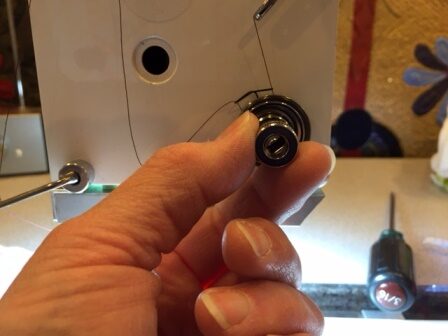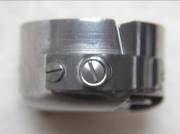Tension troubles on your quilting machine? Try these tricks…
Balanced tension is the goal of every quilter. But it doesn’t take a magician to master it. With a few tricks up your sleeve you’ll be able to tackle it with ease.
Most tension issues appear as “railroad tracks” on the quilt back. In this instance, the bobbin thread lays flat on the quilt back, and the top thread “loops” around it instead of pulling the bobbin thread into the quilt layers.
If you see railroad tracks as your machine moves in all directions, start by tightening your top tension. Go ahead – turn that tension knob a good half-turn or more to the right on a longarm quilting machine! You need to make BIG adjustments on a longarm tensioner to see small impacts on the thread. If you still have railroad tracks, tighten the top tension even more. If you reach a point where the top thread breaks, you’ve gone too far. Then it’s time to take away some of the bobbin tension power so that you have more room for top thread adjustment.

It is OKAY and many times necessaryto adjust bobbin case tension. Toss away your fears, be brave and give yourself permission to change it. Bobbin tension gauges and “drop tests” are great ways to find a starting point for tension but the trick is to use them as a guide, not an absolute.
If you can’t get the results you need by tightening the top tension, then loosen the bobbin tension – even if it means defying some arbitrary number on a tension gauge chart or in a drop test that measures how many inches the bobbin case should slide down if you pick it up by the thread tail. Unlike the top tensioner on a longarm, you’ll only need to make small adjustments to the bobbin case. Turn the larger screw on the outside of the bobbin case counterclockwise only about “5 minutes” if you imagine that the slot on the screw points to the numbers on a clock.

Sometimes your tension will still be unbalanced even though you’ve done your best to balance the tug of war between the top and bobbin tension. If you notice tension changes when you push the machine away from you or to your right when standing at the needle but looks okay when you move in the other two directions, then your quilt is suffering from directional tension issues.
Keep needle flex to a minimum
Directional tension issues are caused by the needle bending too much as you quilt, which affects how well it forms a stitch in unison with your bobbin hook assembly. These factors below affect needle flex. To get the best possible stitch, try these additional tricks to keep needle flex to a minimum:
1. Needle Size. Thick threads, coarse threads like cotton, or strong threads pull on the needle harder. Choose a larger needle if using these products.
2. Quilting Motion Speed. Even if you use a stitch regulator, you can move the machine very quickly. That increases needle flex and adversely affects tension. Slow down your quilting motion for better tension.
3. Stitch Length. If your stitches are far apart, the needle bends farther between stitches. Shorten your stitch length to reduce flexing.
4. Quilt Tautness. Just because you CAN make the quilt tight in a frame doesn’t mean you SHOULD. Keep the quilt snug—but only enough to avoid puckers on the back. Overly tight quilts on the frame increase needle flex and also flatten out the air space in the batting where the threads are supposed to meet.
5. Thread Composition. Cotton thread pulls on a needle harder than polyester, especially if it’s also trying to pull through cotton batting. Try switching to a smoother polyester thread for better tension in all quilting directions.
6. Batting. Thin batting doesn’t provide much room for locking stitches. Also, dense batting makes it hard for the needle to penetrate the quilt layers. For best tension, choose batting with a little loft, and one that is not densely formulated.
7. Fabric Type and Thread Count. Each fabric type introduces variables that affect tension. Fabric that has a high thread count such as batik will make the needle flex more with each stitch. Plus it’s harder for the needle to penetrate densely woven fabric. Choose a smaller needle and smooth thread like polyester to reduce the friction caused by the high fabric thread count.
Each quilt possesses unique characteristics that will make it slightly different from the previous quilt. It could be something as simple as the humidity in the air that changes from one day to the next that will affect your tension. Remember that if you can’t tackle the tension by adjusting your top and/or bobbin tension, it’s time to start looking at the other variables to see if you can make a change. Relax…and if you’re frustrated, walk away for a little while and come back with fresh eyes.
Use logic and common sense to work through your tension troubles. One student recently told me that there must be a “secret handshake” that she wasn’t taught because she was struggling so much with tension. After learning about the other factors that can affect it beyond just adjusting the top or bobbin tension, and much impact any needle flex has on tension, she felt like she was finally a “member of the longarm quilting club.” Well, you don’t need a longarm to learn any “secret handshake” when it comes to tension. These tricks will help you become a tension master in no time. But if you ever encounter a tension issue you can’t resolve, just call us…that’s what customer service is all about at APQS!



